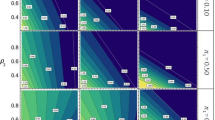Abstract
This paper studies the genetic variation within species using the Eta base functions. We consider the House of Cards Kingman’s model to study genetic variation. This model analyzes the balance between mutation and selection within species, while other forces that produce and maintain genetic variation cause only perturbations. Since this model is a nonlinear integral equation, we introduce a new numerical method for solving the nonlinear mixed Volterra–Fredholm integral equations. We find the best approximation of unknown functions to solve the integral equation using the Eta functions and collocation method. We derive the error bounds of the numerical method and solve some numerical examples to show the high accuracy of the new numerical technique. Using this numerical method, we study the behavior of the probability density of genes within species by considering three different cases of fitnesses for individuals.






Similar content being viewed by others
References
Abdul-Majid W (2011) Linear and nonlinear integral equations, vol 639. Springer
Amin R, Shah K, Asif M, Khan I (2020) Efficient numerical technique for solution of delay volterra–fredholm integral equations using haar wavelet. Heliyon 6(10):e05108
Anatoliĭ K (2006) Theory and applications of fractional differential equations
Bateman Harry (1953) Higher transcendental functions [volumes i–iii], vol 1. McGraw-Hill Book Company
Binh NT, Van Ninh K (2019) Parameter continuation method for solving nonlinear fredholm integral equations of the second kind. Bull Malaysian Math Sci Soc 42(6):3379–3407
Bürger Reinhard (2000) The mathematical theory of selection, recombination, and mutation. John Wiley & Sons
Bürger R (1986) On the maintenance of genetic variation: global analysis of kimura’s continuum-of-alleles model. J Math Biol 24(3):341–351
Bürger R (1989) Mutation-selection balance and continuum-of-alleles models. Math Comput Modell 12(9):1181
Bürger R (1998) Mathematical properties of mutation-selection models. Genetica 102:279–298
Cardone A, Ixaru LG, Paternoster B (2010) Exponential fitting direct quadrature methods for volterra integral equations. Numer Algorithms 55(4):467–480
Coleman JP, Ixaru LG (2006) Truncation errors in exponential fitting for oscillatory problems. SIAM J Numer Anal 44(4):1441–1465
Conte D, Esposito E, Paternoster B, Ixaru LG (2010) Some new uses of the \(\eta \)m (z) functions. Comput Phys Commun 181(1):128–137
Frank Charles KJ (1980) Mathematics of genetic diversity. SIAM
Giacomo TF (1985) Integral equations, vol 5. Courier corporation
Gr IL (1984) Numerical methods for differential equations and applications
Griffiths JF, Griffiths AJF, Wessler SR, Lewontin RC, Gelbart WM, Suzuki DT, Miller JH et al (2005) An introduction to genetic analysis. Macmillan
Guanrong C, Mingjun, C Zhongying C (1997) Approximate solutions of operator equations, vol 9. World Sci
Ixaru LG, Vanden Berghe G (2004) Exponential fitting, vol 568. Springer Science & Business Media
Ixaru L Gr (1997) Operations on oscillatory functions. Comput Phys Commun 105(1):1–19
Ixaru LG (2002) Lilix-a package for the solution of the coupled channel schrödinger equation. Comput Phys Commun 147(3):834–852
James K (2018) Mathematical physics with partial differential equations. Academic Press
John W (2009) Coalescent theory: an introduction. Number 575: 519.2 WAK
Kim KJ, Cools R, Ixaru LG (2002) Quadrature rules using first derivatives for oscillatory integrands. J Comput Appl Math 140(1–2):479–497
Kim KJ, Cools R, Ixaru LG (2003) Extended quadrature rules for oscillatory integrands. Appl Numer Math 46(1):59–73
Kingman JFC (1978) A simple model for the balance between selection and mutation. J Appl Prob 15(1):1–12
Mashayekhi S, Ixaru LG (2020) The least-squares fit of highly oscillatory functions using eta-based functions. J Comput Appl Math 376:112839
Mashayekhi S, Sedaghat S (2021) Fractional model of stem cell population dynamics. Chaos Solitons Fractals 146:110919
Neil ES, David S, Kenneth WW (2013) A mutation-selection model with recombination for general genotypes, vol. 222. Am Math Soc
Shijun L (2003) Beyond perturbation: introduction to the homotopy analysis method. CRC Press
Smith Francis J (1965) Quadrature methods based on the euler-maclaurin formula and on the clenshaw-curtis method of integration. Numer Math 7(5):406–411
Steinsaltz D, Evans SN, Wachter KW (2005) A generalized model of mutation-selection balance with applications to aging. Adv Appl Math 35(1):16–33
Xiaoyan L, Jin X, Zhi L, Jiahuan H (2020) The cardinal spline methods for the numerical solution of nonlinear integral equations. J Chem 2020
Yuan Linglong (2017) A generalization of kingman’s model of selection and mutation and the lenski experiment. Math Biosci 285:61–67
Yuan L (2020) Kingman’s model with random mutation probabilities: convergence and condensation ii. J Stat Phys 181(3):870–896
Ziari Shokrollah, Bica Alexandru Mihai (2019) An iterative numerical method to solve nonlinear fuzzy volterra-hammerstein integral equations. J Intell Fuzzy Syst 37(5):6717–6729
Acknowledgements
Somayeh Mashayekhi was supported by the National Science Foundation grant DBI 2109990. Salameh Sedaghat thanks CIMPA-ICTP Research in Paris Fellowships program. We thank two anonymous referees for giving us many suggestions that helped us to improve our manuscript.
Author information
Authors and Affiliations
Corresponding author
Additional information
Communicated by Hui Liang.
Publisher's Note
Springer Nature remains neutral with regard to jurisdictional claims in published maps and institutional affiliations.
Rights and permissions
Springer Nature or its licensor (e.g. a society or other partner) holds exclusive rights to this article under a publishing agreement with the author(s) or other rightsholder(s); author self-archiving of the accepted manuscript version of this article is solely governed by the terms of such publishing agreement and applicable law.
About this article
Cite this article
Mashayekhi, S., Sedaghat, S. Study the genetic variation using Eta functions. Comp. Appl. Math. 42, 95 (2023). https://doi.org/10.1007/s40314-023-02242-9
Received:
Revised:
Accepted:
Published:
DOI: https://doi.org/10.1007/s40314-023-02242-9
Keywords
- Genetic variation
- House of Cards Kingman’s model
- Eta functions
- Best approximation
- Mixed Volterra–Fredholm integral equations




